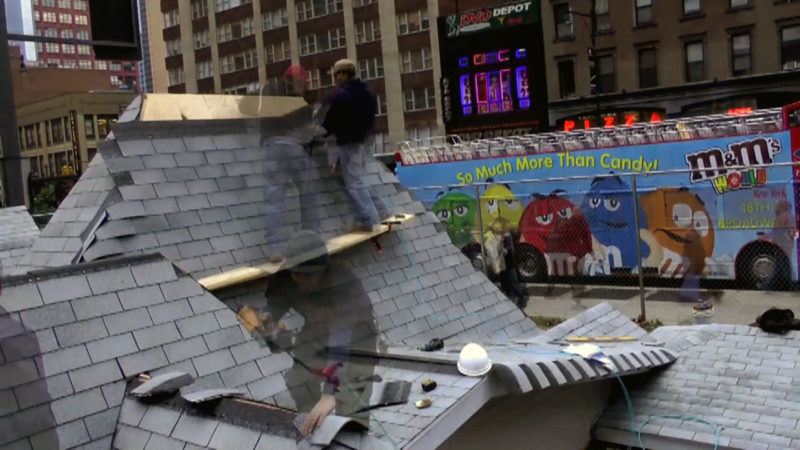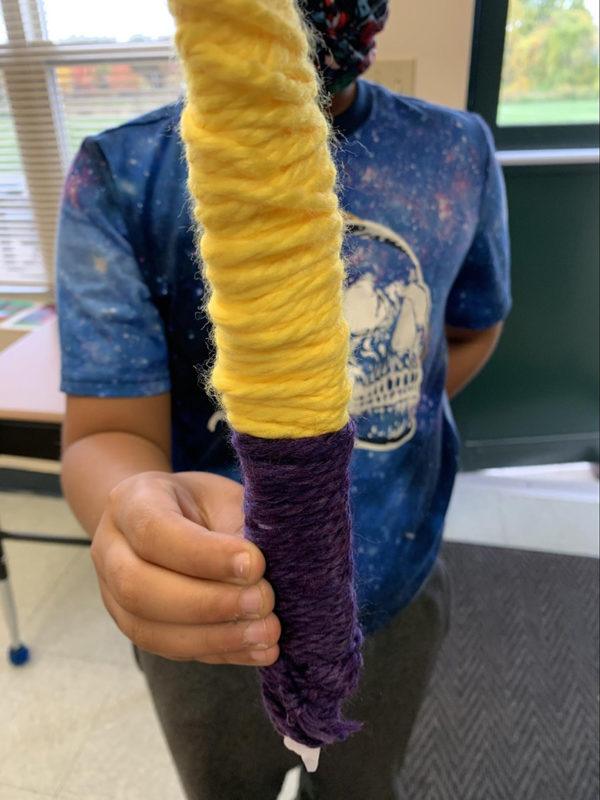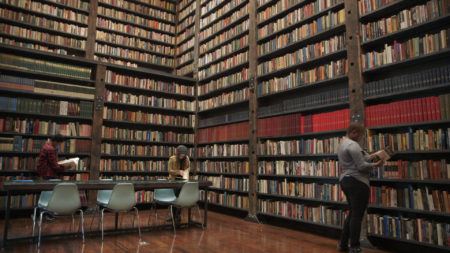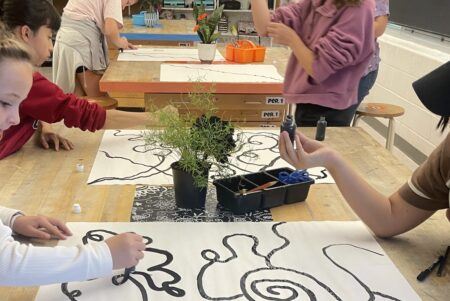Teaching with Contemporary Art
Teaching with Possibilities

Installation of David Brooks’s “Desert Rooftops” in Times Square, New York, NY, 2011. Production still from the New York Close Up film “David Brooks Tears the Roof Off.” © Art21, Inc. 2012.
In the spring of 2020, Damien Hirst initiated a competition on Instagram, with a prize going to the winning answer of this question: “Why are art and kids always so connected?” My answer—“Children just do things. Adults call it art.”—didn’t win the prize, but for a long time, I have thought about making a video playlist to introduce young children to art that isn’t considered traditional. Most of us grew up with a very narrow definition of art. When we looked at art, it was probably in a museum, we could recognize the materials used, and we might even recognize the name of the artist, who was probably a White male. Fast forward twenty-five or fifty years and much less of that holds true. The vast majority of the public is probably confused, wondering what’s going on with contemporary art.
I start teaching art classes at my school with the children in kindergarten. As much as I focus on materials and their proper use and care, I start by introducing radical ideas of what art can look like and how art can make a difference. I like to think that the sooner I can broaden the idea of the traditional definition of art, the sooner and the longer the students will consider themselves artists.
My playlist consists of artists who use nontraditional materials and techniques that don’t come to mind when one typically thinks of art. The first is a work by David Brooks. I loved this piece the moment I saw it. With this work, Brooks not only gets to the question of what art is, which he seems to brush off, but also takes on more universal ideas, like relationships between the environment and man and the wild and the tame. He even compares suburban sprawl to a virus. He has a sense of humor about his work, and he’s fascinated by reactions from the public and the media. He seems to think: If the purpose of art is to get people to have feelings and reactions, make associations and projections, then this piece accomplishes it. “It’s not quite normal,” Brooks says, about the piece.

Photo by Catherine Karp
When showing this video to young students (kindergarten through fourth grade), it is mind blowing to be prompted to think “What if?” Brooks brings his own childlike “what-if” questions and his personal interests to an audience that’s eager for a role model. Seeing scale models of things like houses and trains are common and familiar, but seeing just a roof by itself is different. In my choice-based classroom, students often dream up their own projects, and I facilitate or coproduce their projects with them. Building with cardboard and assorted recycled materials is a perennial favorite.
An artist pair who I really love to show in my classroom is Jennifer Allora and Guillermo Calzadilla. This two-minute clip is one of my all-time favorites, and I use it with students through the eighth grade. The fact that the artists begin by talking about a mundane and matter-of-fact material, like chalk, and make connections to its geological origins, its symbolic power, and its fate to be arrested is a magical combination. Some preparation and some discussion after viewing are needed to comprehend what happens in this video. I love that it allows my students, in the name of art viewing, to look through the back door at a political process in a foreign country. Planting the seeds for respectful artistic and political exploration is a great thing to do in the art classroom. Once young students understand the general use and care of materials, I don’t mind if they experiment with them. In a main segment of the Allora & Calzadilla video, there’s a powerful scene of the cleaners coming and washing away any sign of the chalk ever being there. I love the symbolism of the cleaning up at the end of the protest, similar to cleaning up at the end of art class.
I introduced my students to the artist Judith Scott (from the Creative Growth Art Center segment) this fall. Since we are all living in this weird time, of not being able to hug or even touch each other, I thought it would be wonderful to look at an artist whose work is all about touch and uses such a tactile material like yarn. The segment featuring Scott is very short, just over a minute long, but it contains tons of shocking facts about her life (I refer to the section 7:49–8:54). Due to these revelations, I use the film with students in fourth through sixth grade. I also showed students a short segment from the Nick Cave video, in which he talks about the need to develop a thick skin. I see these two artists’ ideas connecting around the idea of wrapping, protecting, or hiding something precious. After a discussion and reflection about the two artists, the students wrote anything they wanted on a piece of paper, as an exercise in making a token. They could write hopes, dreams, fears, feelings, and so forth. The students proceeded to roll the paper up or smash it into a ball and wrap it in any way they desired.

Photo by Catherine Karp
In my classroom, I have also enjoyed sharing the work of Glenn Ligon with my fourth through eighth grade students. I start with the section beginning at 8:16, when Ligon reflects that he “love(s) the idea of making ideas.” He spends a long time exploring materials and letting ideas percolate. He speaks of working for six months trying to get the oil sticks to do what he wanted, until he realized that he needed to forget what he was trying to do and just follow the material. The section I like the most begins at 12:47, when he says that one day he went into a neon shop in his building. He had a discussion with the owner about the possibility of making black neon, and the owner said, “That’s against the laws of physics.” Ligon seems to take that as a challenge, much like students do when they ask to do something that’s not usually allowed. This sort of thoughtful wonder is crucial to a student’s development of not just artistic curiosity or skill but also curiosity in general and confidence in following one’s hunches, which may just lead a student to follow a dream.
When the school year comes to an end and the kindergarten students prepare for their graduation ceremony, it has become a tradition for them to go outside and paint long murals with their feet. Plenty of paint, long rolls of butcher paper, brushes, and water are all they need. Children help each other to take off their shoes and socks and even carry one another over to the paper so they can start walking around on it. The results are fit for a museum exhibition.
Watch Catherine’s playlist, “Teaching with Possibilities.”



